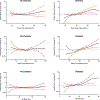Diabetes Status Modifies the Association Between Different Measures of Obesity and Heart Failure Risk Among Older Adults: A Pooled Analysis of Community-Based NHLBI Cohorts
- PMID: 34860539
- PMCID: PMC8792339
- DOI: 10.1161/CIRCULATIONAHA.121.055830
Diabetes Status Modifies the Association Between Different Measures of Obesity and Heart Failure Risk Among Older Adults: A Pooled Analysis of Community-Based NHLBI Cohorts
Abstract
Background: Obesity and diabetes are associated with a higher risk of heart failure (HF). The interrelationships between different measures of adiposity-overall obesity, central obesity, fat mass (FM)-and diabetes status for HF risk are not well-established.
Methods: Participant-level data from the ARIC study (Atherosclerosis Risk in Communities; visit 5) and the CHS (Cardiovascular Health Study; visit 1) cohorts were obtained from the National Heart, Lung, and Blood Institute Biologic Specimen and Data Repository Information Coordinating Center, harmonized, and pooled for the present analysis, excluding individuals with prevalent HF. FM was estimated in all participants using established anthropometric prediction equations additionally validated using the bioelectrical impedance-based FM in the ARIC subgroup. Incident HF events on follow-up were captured across both cohorts using similar adjudication methods. Multivariable-adjusted Fine-Gray models were created to evaluate the associations of body mass index (BMI), waist circumference (WC), and FM with risk of HF in the overall cohort as well as among those with versus without diabetes at baseline. The population attributable risk of overall obesity (BMI≥30 kg/m2), abdominal obesity (WC>88 and 102 cm in women and men, respectively), and high FM (above sex-specific median) for incident HF was evaluated among participants with and without diabetes.
Results: The study included 10 387 participants (52.9% ARIC; 25.1% diabetes; median age, 74 years). The correlation between predicted and bioelectrical impedance-based FM was high (R2=0.90; n=5038). During a 5-year follow-up, 447 participants developed HF (4.3%). Higher levels of each adiposity measure were significantly associated with higher HF risk (hazard ratio [95% CI] per 1 SD higher BMI=1.15 [1.05, 1.27], WC=1.22 [1.10, 1.36]; FM=1.13 [1.02, 1.25]). A significant interaction was noted between diabetes status and measures of BMI (P interaction=0.04) and WC (P interaction=0.004) for the risk of HF. In stratified analysis, higher measures of each adiposity parameter were significantly associated with higher HF risk in individuals with diabetes (hazard ratio [95% CI] per 1 SD higher BMI=1.29 [1.14-1.47]; WC=1.48 [1.29-1.70]; FM=1.25 [1.09-1.43]) but not those without diabetes, including participants with prediabetes and euglycemia. The population attributable risk percentage of overall obesity, abdominal obesity, and high FM for incident HF was higher among participants with diabetes (12.8%, 29.9%, and 13.7%, respectively) versus those without diabetes (≤1% for each).
Conclusions: Higher BMI, WC, and FM are strongly associated with greater risk of HF among older adults, particularly among those with prevalent diabetes.
Keywords: body mass index; diabetes mellitus; fat mass; heart failure; waist circumference.
Figures


References
-
- Virani SS, Alonso A, Benjamin EJ, Bittencourt MS, Callaway CW, Carson AP, Chamberlain AM, Chang AR, Cheng S, Delling FN, et al. American Heart Association Council on Epidemiology and Prevention Statistics Committee and Stroke Statistics Subcommittee. Heart Disease and Stroke Statistics-2020 Update: A Report From the American Heart Association. Circulation 2020;141:e139–e596. - PubMed
-
- Pandey A, Cornwell WK 3rd, Willis B, Neeland IJ, Gao A, Leonard D, DeFina L and Berry JD. Body Mass Index and Cardiorespiratory Fitness in Mid-Life and Risk of Heart Failure Hospitalization in Older Age: Findings From the Cooper Center Longitudinal Study. JACC Heart Fail 2017;5:367–374. - PubMed
-
- Pandey A, Kondamudi N, Patel KV, Ayers C, Simek S, Hall ME, Musani SK, Blackshear C, Mentz RJ, Khan H, et al. Association Between Regional Adipose Tissue Distribution and Risk of Heart Failure Among Blacks. Circ Heart Fail 2018;11:e005629. - PubMed
-
- Lavie CJ, Laddu D, Arena R, Ortega FB, Alpert MA and Kushner RF. Healthy Weight and Obesity Prevention: JACC Health Promotion Series. J Am Coll Cardiol 2018;72:1506–1531. - PubMed
Publication types
MeSH terms
Grants and funding
LinkOut - more resources
Full Text Sources
Medical
Research Materials
Miscellaneous

